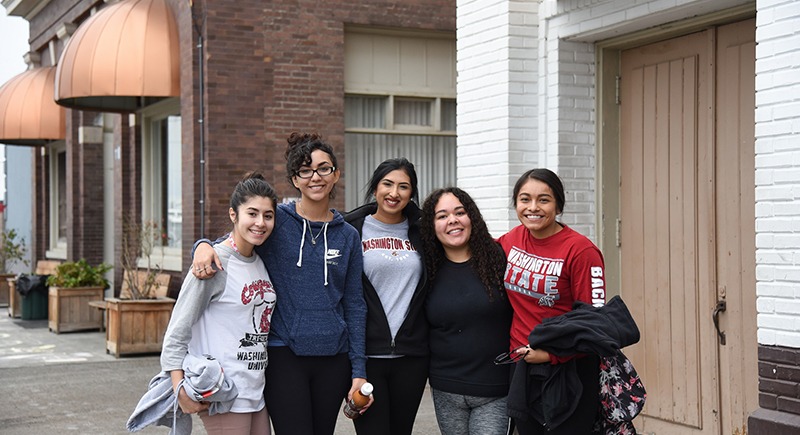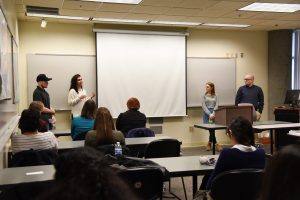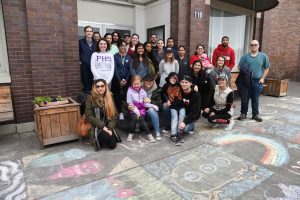
December 19, 2018 WSU Tri-Cities students explore homelessness at Tri-City Union Gospel Mission
By Maegan Murray, WSU Tri-Cities
RICHLAND, Wash. – Eyes were opened and hearts touched as students in a Washington State University Tri-Cities psychology statistics course recently worked with homeless people at Tri-City Union Gospel Mission.

A student in a WSU Tri-Cities psychology statistics course volunteers her time to clean the kitchen at the Tri City Union Gospel Mission in Pasco.
Each semester, Janet Peters, clinical assistant professor of psychology, has her students work with a local service-based organization to provide them with real-world experience.
“These types of opportunities provide students with a practical look into how they can use statistics in psychology,” Peters said. “They’re also providing a service to a local organization who may not have the time to dig deep into their data and do this type of analysis.”
The students spent the semester analyzing data from the facility determining factors that influence or relate to homelessness. Tri-City Union Gospel Mission, in turn, can use the data to demonstrate to donors the need for its services and educate the community.
The class also spent a day volunteering at the homeless shelter — cleaning bathrooms, organizing the food pantry, scrubbing floors, folding laundry and decorating their sidewalks with sidewalk chalk, among other tasks.
For some students, the opportunity proved deeply personal.
“Having been homeless several times, it was humbling being able to serve and give back to resources that have such a large impact in our community,” said senior student Jacob Hafen. “As we demonstrated with our projects, homelessness isn’t necessarily centered around addiction or a mental disorder, although sure we do see homeless people who are suffering in either of those instances.”
Surprising factors contribute to homelessness
The students aimed to identify a relationship between how long an individual might be homeless and variety of influencing factors, including:
- Employment status
- Education level
- Drug use
- Number of children
- And a variety of other issues

A group of students in a WSU Tri-Cities psychology statistics course present their data analysis on data from the Tri City Union Gospel Mission this semester. The course partnered with the organization to perform a detailed analysis on data regarding their homeless clients.
Approximately 34 percent of the residents at the mission had been living with friends or family and, for whatever reason, it didn’t work out. Approximately 21 percent of the residents had been kicked out of their home. Approximately 14 percent of the residents had suffered from domestic violence.
The average amount of days stayed at the facility over the course of three years was just over a month (37 days) – a surprise to many of the students. And the leading cause for longer stays in the shelter was eviction, followed by domestic violence.
Drug use wasn’t as high of a determining of a factor as many of the students initially predicted. In their analysis, they found that a history of addiction was not related to how long the women stayed at the shelter.
Level of education, many said, was also surprising when determining if that had an impact on length of stay. High school graduates typically stayed slightly longer – 43 days, as compared to non-high school grads, who stayed for an average of 29 days.
While all the information was self-reported and dependent on the individual’s honesty, it proved to break stereotypes on homelessness for many of the students.
For junior psychology major Rocio Marquez, it was surprising to find that employed individuals didn’t seem to have an easier path. Employed individuals, she said, might stay just as long as non-employed individuals.
“You would think that because they’re employed, they will get back on their feet much faster, and they don’t,” she said.
Profound impact

A WSU Tri-Cities psychology statistics course poses for a photo after volunteering at the Tri City Union Gospel Mission. The students spent the day cleaning the facilities, folding laundry, in addition to other tasks.
Junior Sarah Wright said the project has allowed her and her classmates to better understand the Tri-Cities community as a whole.
“Homelessness is much closer to home than we realize,” she said. “This could be your brother, your sister, your mother. It doesn’t take much.”
With former experience being homeless, himself, Hafen said often times, there are no easy explanations or answers to the issue of homelessness ― a concept that many of the students said they came to realize.
“Homelessness is really an ugly truth, and it’s good for people to realize that this is part of some peoples’ lives,” Hafen said. “We have the stereotype of ‘this is what homelessness is.’ Giving our time with this project helps debunk that.”
Media contacts:
- Janet Peters, clinical assistant professor of psychology, 509-372-7431, janet.peters@wsu.edu
- Maegan Murray, WSU Tri-Cities public relations specialist, 509-372-7333, maegan_murray@wsu.edu





